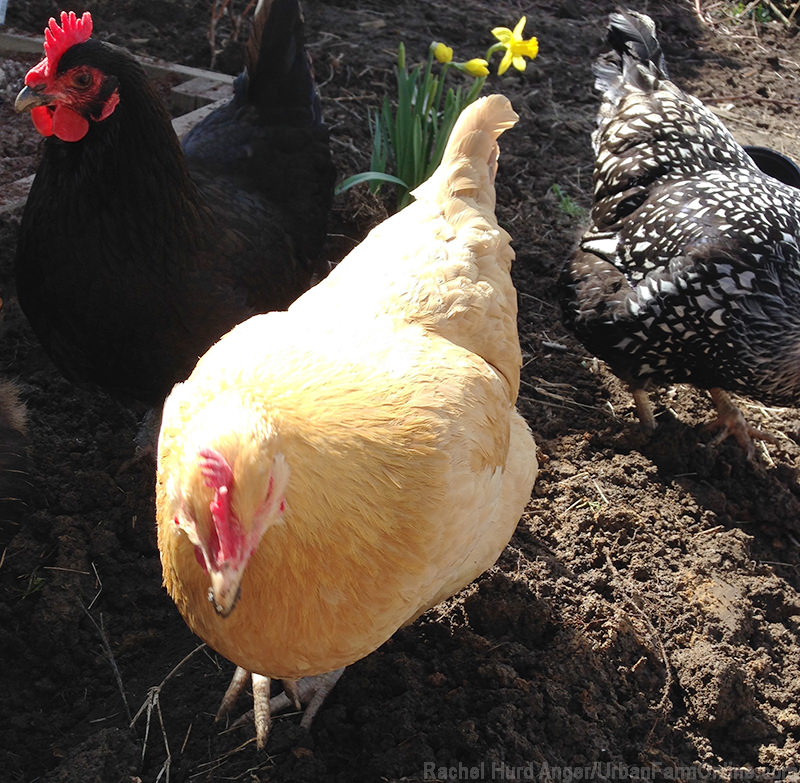

Chickens are good at finding places to dust bathe. They will snuggle up between the roots of old trees, lie down in the garden, and fluff their feathers in decomposing mulch. Dust bathing absorbs oil from their skin, and wood ash coats the skin to become a barrier protecting from mite infestations. As a preventive healthcare in chickens, dust bathing has no substitute.
The biggest problem with allowing your flock to bathe in the random areas around your yard is that long periods of rain or snow will prevent them from being able to clean themselves. Providing a space where the flock can bathe whenever it pleases will deter small insects from making a home on your hens, keeping them clean and happy.
When we started making changes to our backyard last year, we eliminated some of the spaces where the flock enjoyed bathing. Those changes, plus a winter of heavy snows that kept the flock cooped up, recent heavy rains and some visiting wild birds, we experienced the perfect recipe for mites. We had it coming!
What I learned is that a dedicated dust bath is not an indulgent spa, but a simple bathtub. It’s a feature of the living space a chicken can’t live without.
For my current flock of eight, I repurposed a former 4-by-4-foot raised bed that was moved when we redesigned the yard. The garden bed doesn’t take up much space, and it’s just the right size for the majority of the flock to bathe at the same time. Here’s the recipe we used to fill it:

Dust Bath Recipe
- 1 bag peat moss
- 2 bags play sand
- wood ashes
- *sprinkle of food-grade diatomaceous earth (DE)
Peat moss is light, fluffy and absorbent, which makes it perfect for pulling oils from the skin; sand adds weight to the mixture without clumping; and wood ashes will coat the skin with a barrier to keep mites out. Normally, I wouldn’t recommend DE as an amendment to a dust bath as a preventive for two reasons:
- While DE is safe on skin, it is damaging to lung tissue, so it’s not good for your chickens to kick it up and breathe it in.
- Wood ashes are a safe and effective preventive against mites, making DE unnecessary.
Because I already have mites in my flock, I made the tough decision to add DE to the dust bath to help kill existing mites. Mites have a life cycle of only five to seven days, but in that time they’ll lay up to 10,000 eggs each. As the flock kicks out its dust bath ingredients, I’ll eventually add more of everything but the DE so that the concentration of DE will lessen over time.
My flock’s favorite place to relax and unwind was under my overgrown blackberry bushes, in the decomposing mulch where we used to sprinkle wood ashes. A new shed stands there now. Once I filled the dust bath, I decorated it. The chickens helped by plucking worms from the soil I shoveled as I planted daffodils in the front. Then I moved two blackberry canes that popped up next to the shed to one side of the dust bath, and I planted a new raspberry cane on the other side. These will grow quickly to provide cover and low-growing forage the flock loves in the summer. Soon, we’ll add a simple roof structure so the dust bathe stays dry during weather that helps mites thrive.
The dust bath is just one component to tackling a mite infestation. Next week, I’ll talk about the other ways I’m working to defeat mites in my flock.





2 replies on “Give Your Flock Space to Bathe”
[…] a safe haven for parasites introduced to the flock through the winter when they weren’t able to dust-bathe properly. We moved the coop, and I raked the loose material. Then I scraped and shoveled the […]
[…] and provide enjoyable hiding places. Underneath shrubs and berry canes is also a great place to add dust-bathing materials, like a sand, peat and wood ash […]